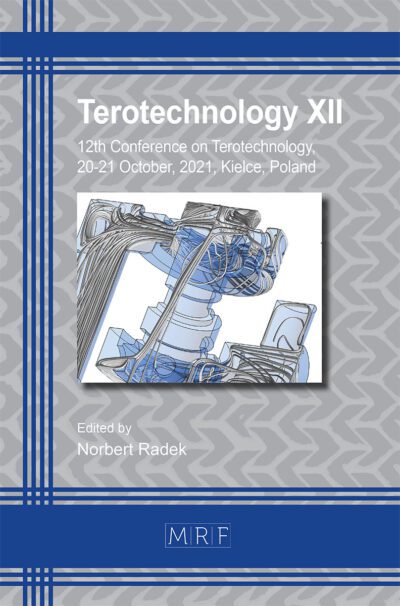Prediction of surface topography change during chain of selective laser melting and burnishing
TEIMOURI Reza, SKOCZYPIEC Sebastian, GRABOWSKI Marcin
download PDFAbstract. The present study developed theoretical models for simulation of surface topography and roughness of parts produced by the selective laser melting (SLM) process and their evolution after burnishing as post-treatment. The simulation algorithm has been integrated by combining principles of selective laser melting process, i.e., formation of the melt pool and kinematic of motion, followed by mechanic of burnishing through Z-map approach. To verify the simulation results, 316L stainless steel was 3D printed and then burnished under different burnishing depth. 3D surface profile and surface roughness of as-printed material and those post-processed by surface burnishing (SB) were measured through microscopic examination and surface roughness measurement, respectively. The results obtained through comparison of confirmatory experiments and simulation model affirmed that the proposed approach is accurate enough to predict the surface topography and roughness of as-printed and post-treated samples.
Keywords
Surface Roughness, Selective Laser Melting, Burnishing, Simulation
Published online 4/19/2023, 10 pages
Copyright © 2023 by the author(s)
Published under license by Materials Research Forum LLC., Millersville PA, USA
Citation: TEIMOURI Reza, SKOCZYPIEC Sebastian, GRABOWSKI Marcin, Prediction of surface topography change during chain of selective laser melting and burnishing, Materials Research Proceedings, Vol. 28, pp 31-40, 2023
DOI: https://doi.org/10.21741/9781644902479-4
The article was published as article 4 of the book Material Forming
![]() Content from this work may be used under the terms of the Creative Commons Attribution 3.0 license. Any further distribution of this work must maintain attribution to the author(s) and the title of the work, journal citation and DOI.
Content from this work may be used under the terms of the Creative Commons Attribution 3.0 license. Any further distribution of this work must maintain attribution to the author(s) and the title of the work, journal citation and DOI.
References
[1] J. Bedmar, N. Abu-ward, S. García-Rodríguez, B. Torres, J. Rams, Influence of the surface state on the corrosion behaviour of the 316 L stainless steel manufactured by laser powder bed fusion, Corros. Sci. 207 (2022) 110550. https://doi.org/10.1016/j.corsci.2022.110550
[2] L. Chen, B. Richter, X. Zhang, K.B. Bertsch, D.J. Thoma, F.E. Pfefferkorn, Effect of laser polishing on the microstructure and mechanical properties of stainless steel 316L fabricated by laser powder bed fusion, Mater. Sci. Eng. A 802 (2021) 140579. https://doi.org/10.1016/j.msea.2020.140579
[3] S. Bagehorn, J. Wehr, H.J. Maier, Application of mechanical surface finishing processes for roughness reduction and fatigue improvement of additively manufactured Ti-6Al-4V parts, Int. J. Fatigue 102 (2017) 135-142. https://doi.org/10.1016/j.ijfatigue.2017.05.008
[4] H. Zhang, R. Chiang, H. Qin, Z. Ren, X. Hou, D. Lin, G.L. Doll, V.K. Vasudevan, Y. Dong, C. Ye, The effects of ultrasonic nanocrystal surface modification on the fatigue performance of 3D-printed Ti64, Int. J. Fatigue 103 (2017) 136-146. https://doi.org/10.1016/j.ijfatigue.2017.05.019
[5] H. Soyama, Y. Okura, The use of various peening methods to improve the fatigue strength of titanium alloy Ti6Al4V manufactured by electron beam melting, AIMS Mater. Sci. 5 (2018) 1000-1015. https://doi.org/10.3934/matersci.2018.5.1000
[6] H. Soyama, C. Kuji, Improving effects of cavitation peening, using a pulsed laser or a cavitating jet, and shot peening on the fatigue properties of additively manufactured titanium alloy Ti6Al4V, Surf. Coat. Tech. (2022) 129047. https://doi.org/10.1016/j.surfcoat.2022.129047
[7] X.L. Yuan, Y.W. Sun, L.S. Gao, S.L. Jiang, Effect of roller burnishing process parameters on the surface roughness and microhardness for TA2 alloy, Int. J. Adv. Manuf. Technol. 85 (2016) 1373-1383. https://doi.org/10.1007/s00170-015-8031-0
[8] G. Rotella, L. Filice, F. Micari, Improving surface integrity of additively manufactured GP1 stainless steel by roller burnishing, CIRP Annals, 69 (2020) 513-516.
[9] S. Sunny, R. Mathews, H. Yu, A. Malik, Effects of microstructure and inherent stress on residual stress induced during powder bed fusion with roller burnishing, Int. J. Mech. Sci. 219 (2022) 107092. https://doi.org/10.1016/j.ijmecsci.2022.107092
[10] R.K. Raaj, P.V. Anirudh, C. Karunakaran, C. Kannan, A. Jahagirdar, S. Joshi, A.S.S. Balan, Exploring grinding and burnishing as surface post-treatment options for electron beam additive manufactured Alloy 718, Surf. Coat. Tech. 397 (2020) 126063. https://doi.org/10.1016/j.surfcoat.2020.126063
[11] A.C. de Bruijn, G. Gómez-Gras, M.A. Pérez, On the effect upon the surface finish and mechanical performance of ball burnishing process on fused filament fabricated parts, Additive Manufacturing 46 (2021) 102133. https://doi.org/10.1016/j.addma.2021.102133
[12] J. Ning, E. Mirkoohi, Y. Dong, D.E. Sievers, H. Garmestani, S.Y. Liang, Analytical modeling of 3D temperature distribution in selective laser melting of Ti-6Al-4V considering part boundary conditions, J. Manuf. Process. 44 (2019) 319-326. https://doi.org/10.1016/j.jmapro.2019.06.013
[13] B. Liu, G. Fang, L. Lei, An analytical model for rapid predicting molten pool geometry of selective laser melting (SLM), Appl. Math. Model. 92 (2021) 505-524. https://doi.org/10.1016/j.apm.2020.11.027
[14] H.Q. Chen, Q.H. Wang, Modelling and simulation of surface topography machined by peripheral milling considering tool radial runout and axial drift, Proceedings of the Institution of Mechanical Engineers, Part B: Journal of Engineering Manufacture 233 (2019) 2227-2240. https://doi.org/10.1177/0954405419838384

































